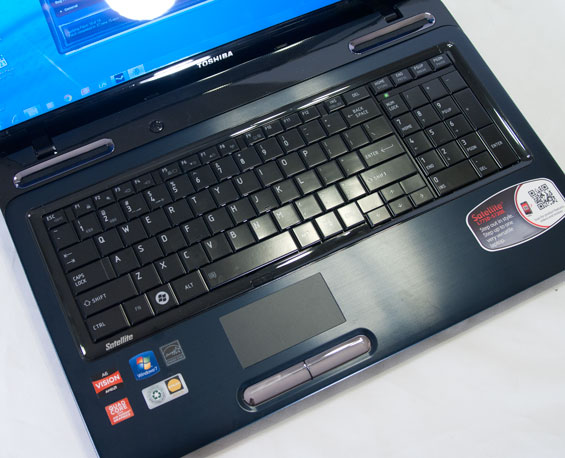Llano in the Wild: Toshiba's Satellite L775D-S7206
by Dustin Sklavos on August 12, 2011 12:45 AM ESTBaby Steps into the Present
Credit where credit is due to Toshiba: while a lot of the design points I took issue with on their older laptops are still present in the Satellite L775D-S7206, they're still definitely progressing with each refresh. In the case of the L775D-S7206, much of the shell has been upgraded to an attractive navy blue aluminum finish. It still picks up smudges and fingerprints, but it looks nowhere near as cheap as the explosion-at-the-gloss-factory finishes of old.
I'm more liable to forgive Toshiba's design trespasses on a notebook like this one because of its low pricetag, but they're still worth pointing out: glossy plastic does not belong on the screen bezel. In fact, that's really part of the problem with this notebook: while the aluminum finish is fantastic, Toshiba has managed to put glossy plastic just about everywhere you don't want it. The screen bezel should be devoid of glossy plastic yet there it is, and worse, the keyboard is still comprised of the same flat, glossy keys that I derided last generation. There's something seriously wrong when the cheaper notebooks in your line have better keyboards by virtue of just using matte plastic instead of gloss.

What makes that more frustrating is that Toshiba's keyboard layout is honestly one of the best I've seen. While Clevo continues to be utterly perplexed by the prospect of integrating a 10-key with the rest of the keyboard, Toshiba's layout is incredibly smart and as close to ideal as you could ask for. No keys are missing, the 10-key is the bog standard layout, and document navigation keys have their own row above the 10-key. Toshiba's layout is as good as I could ask for, I just wish they'd at least upgrade the rest of their notebooks to the keyboard they're using on their Tecra and Portege lines, or at least get rid of the gloss.
You'll also notice a stunning lack of media keys or touch-sensitive shortcuts above the keyboard. I've never liked the touch-sensitive strips and I'm happy to see it gone, though a few media shortcut keys would've been appreciated even as Fn combinations.
The touchpad is much easier to use, and thankfully it isn't a part of the chassis the way most inexpensive notebooks make it. You can see clearly in the photo that it's a different piece, and it's smooth and easy to track. The action on the mouse buttons is a little stiff, but not a huge deal: if you don't have an external mouse handy, you could do a lot worse than Toshiba's touchpad. The pad itself could be a bit larger, and the buttons are perhaps too large, but it works well regardless.
Honestly my biggest gripe is that Toshiba is still futzing with flat glossy keys and bulbous shell designs on their consumer notebooks. My experiences with Toshiba notebooks, barring design decisions, have typically been very positive, and anecdotally I have yet to see one actually die, no matter the age. Toshiba offers great options for budget users, and the navy blue aluminum panels are a major upgrade, but the overall curvy design still feels unattractive to me.
















74 Comments
View All Comments
elrui - Monday, August 15, 2011 - link
At 450 bucks Asus offers an A3400 with 1gb discrete graphics. I bought one and am amazed at how capable it is.Novaguy - Monday, August 15, 2011 - link
I think I just saw a Toshiba with a A4-3300M out there at Best Buy. I think it was priced at $399, so it was brushing up against E-350 pricing territory.I have not heard anything about this chip, though. Would like to get some reviews.
Baffo - Thursday, August 18, 2011 - link
I noticed in the laptop specs, only mention was made for 1x2GB and 1x4GB configurations; is that simply as tested (in which case, was it tested with 2GB or 4GB RAM? Can be big difference for Win7 depending on what is running..), or as available from Toshiba? Since we are talking about an IGP (sorry, iGPU ;-) ), you are contending for memory bandwidth for GPU and CPU access, adding memory bandwidth can only help both. Or is the memory controller not sophisticated enough to accomplish what even early gen Athlon CPUs could do? If so, is DDR-1600 the only way to free up RAM access bottlenecks? Could be a real cheap upgrade and cost savings to buy the 2GB version, and buy an extra 2GB chip to boost performance both due to physical RAM exhaustion and interleaving for collision reduction.Valitri - Tuesday, January 17, 2012 - link
Just wanted to give my 2 cents to the value of the A6 and why I just purchased one. I grabbed a Samsung 3 series from BestBuy yesterday for $399. It has the A6 3420m, 4Gb ram, 500GB 5400rpm hard drive, 1.3" thick and about 5 lbs. My reasoning for buying this was to take on an overseas deployment where it very well could not make it back. I wanted it cheap, able to skype, but also use it to play some games as my time sink. I've got WoW and about 15 games in steam loading on it as we speak, I'll repost when I can give more input on the performance. So far in windows, just loading webpages in chrome, downloading avast, steam, wow client, it all seems just fine. I'm really curious to see how well it will launch these games.